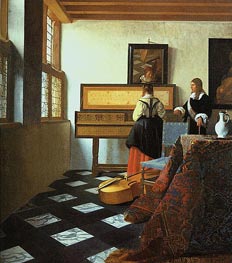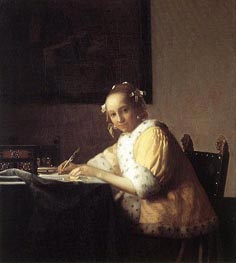The Astronomer, 1668 by Johannes Vermeer, van Delft
Canvas Print - 1086-VVD
Location: Louvre Museum, Paris, FranceOriginal Size: 50 x 45 cm
Giclée Canvas Print | $61.67 USD
Your Selection
Customize Your Print
By using the red up or down arrows, you have the option to proportionally increase or decrease the printed area in inches as per your preference.
*Max printing size: 24 x 21.6 in
*Max framing size: Long side up to 28"
"The Astronomer" will be custom-printed for your order using the latest giclée printing technology. This technique ensures that the Canvas Print captures an exceptional level of detail, showcasing vibrant and vivid colors with remarkable clarity.
Our use of the finest quality, fine-textured canvas lends art reproductions a painting-like appearance. Combined with a satin-gloss coating, it delivers exceptional print outcomes, showcasing vivid colors, intricate details, deep blacks, and impeccable contrasts. The canvas structure is also highly compatible with canvas stretching frames, further enhancing its versatility.
To ensure proper stretching of the artwork on the stretcher-bar, we add additional blank borders around the printed area on all sides.
Our printing process utilizes cutting-edge technology and employs the Giclée printmaking method, ensuring exceptional quality. The colors undergo independent verification, guaranteeing a lifespan of over 100 years.
Please note that there are postal restrictions limiting the size of framed prints to a maximum of 28 inches along the longest side of the painting. If you desire a larger art print, we recommend utilizing the services of your local framing studio.
*It is important to mention that the framing option is unavailable for certain paintings, such as those with oval or round shapes.
If you select a frameless art print of "The Astronomer" by Vermeer, it will be prepared for shipment within 48 hours. However, if you prefer a framed artwork, the printing and framing process will typically require approximately 7-8 days before it is ready to be shipped.
We provide complimentary delivery for up to two unframed (rolled-up) art prints in a single order. Our standard delivery is free and typically takes 10-14 working days to arrive.
For faster shipping, we also offer express DHL shipping, which usually takes 2-4 working days. The cost of express shipping is determined by the weight and volume of the shipment, as well as the delivery destination.
Once you have added the paintings to your shopping cart, you can use the "Shipping estimates" tool to obtain information about available transport services and their respective prices.
All unframed art prints are delivered rolled up in secure postal tubes, ensuring their protection during transportation. Framed art prints, on the other hand, are shipped in cardboard packaging with additional corner protectors for added safety.
Painting Information
In this intimate scene of intellectual pursuit, Vermeer captures a moment of concentrated study with characteristic precision and luminosity. An astronomer, clad in a rich blue-gray robe, leans forward at his desk, his attention fixed upon a celestial globe while sunlight streams through leaded windows, creating a contemplative atmosphere charged with scientific curiosity.
The palette is quintessentially Vermeer - dominated by that extraordinary interplay between light and shadow. The cool daylight filtering through the window transforms into pools of warm gold as it falls across the scene, highlighting the celestial globe, the scholar's robe, and the tapestry-covered table. The rich ultramarine of the robe, likely achieved with precious lapis lazuli, anchors the composition with its deep, resonant tone.
Vermeer's technical mastery is evident in his handling of light effects. The artist employs his characteristic pointillé technique - tiny dots of pure paint that create a subtle, shimmering quality, particularly visible in the illuminated areas. The careful gradation of tones in the wall's shadows and the precise rendering of the window's geometric pattern demonstrate his supreme control over perspective and spatial relationships. The globe itself is a tour de force of observational painting, its metallic stand and cartographic details rendered with exquisite precision.
The composition reveals Vermeer's genius for spatial organization. The window frame and table create strong horizontal and vertical lines that ground the image, while the astronomer's reaching pose introduces a dynamic diagonal. The careful placement of objects - the globe, books, and the partially visible painting of Moses in the background - creates a subtle symbolic dialogue about divine providence and human inquiry. This painting represents more than mere documentation of scientific pursuit; it embodies the Dutch Golden Age's fascination with empirical observation and its relationship to divine order.
Created in 1668, the work emerges from a period when the Netherlands stood at the forefront of scientific discovery. That Vermeer chose to depict his subject in mid-thought, rather than in demonstrative action, speaks to a deeper meditation on the nature of intellectual discovery. The painting becomes not just a representation of scientific pursuit, but a contemplation of human consciousness itself, rendered in light and shadow.





















